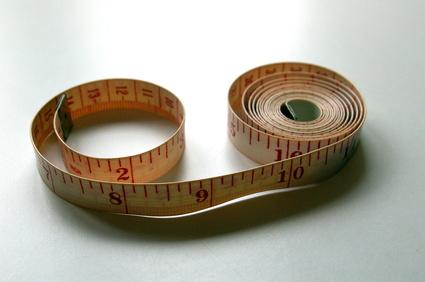Setting a weight loss goal can help you to stick to your plan, but it’s a lot more complicated than picking a number on the scale. Your scale weight isn’t always indicative of your true health. Other methods, such as body fat, waist-to-hip ratio and dress size, combine to give you a full picture of the state of your health. Set goals in each area to calculate your weight loss goal. A bonus to setting goals this way is that you have many more milestones to celebrate.
Step 1
Look up the recommended weight range for your height. Body mass index (BMI) is a ratio of how much you weigh divided by your height in inches squared. The Centers for Disease Control and Prevention states that a healthy BMI is between 18.5 and 24.5. Use this as a goal for your weight on the scale. BMI becomes less valid as a measurement the more muscular you are.
Step 2
Set a body fat percentage goal. Perhaps a better measurement of your weight loss is the body fat percentage, which takes into account your body composition. A paper from the Maricopa County Department of Health in Arizona suggests that a healthy body fat percentage ranges from 17 to 29 percent for women and 10 to 20 percent for men, though measurements in the lower range show true fitness. The most accurate way to measure your body fat is with calipers, but it’s difficult to use them. Instead, use a body fat calculator online or ask your doctor to measure it for you. You can also purchase a scale that measures it for you. If your body weight is more than 30 percent currently, set your goal to get it below that initially, then change the goal to decrease it once you’ve met the first goal.
Step 3
Factor in your waist-to-hip ratio. To determine your waist-to-hip ratio, you simply divide your waist measurement by your hip measurement. The University of Maryland Medical Center states that those who have a high ratio are “apple shaped” and carry higher risks for heart disease, though it is still not clear why. By decreasing your overall body fat, you’ll improve your wait to hip ratio and your health. If you’re a woman, you want the ratio to be below 0.80. If you’re a man, you should aim for less than 0.95.
Photo Credit
- tape measure image by MichMac from Fotolia.com





